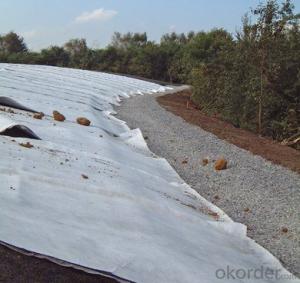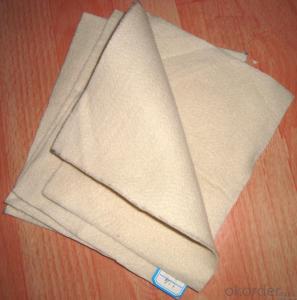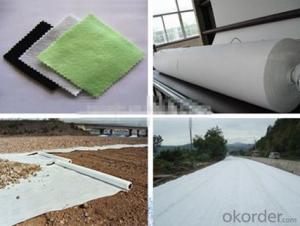L&M Geotextile PP Non-Woven Geotextile Fabric Materials for Railway
- Loading Port:
- China main port
- Payment Terms:
- TT OR LC
- Min Order Qty:
- 1000 m²
- Supply Capability:
- 1000000 m²/month
OKorder Service Pledge
OKorder Financial Service
You Might Also Like
Specification
Geotextile Fabrics
CNBM landscape fabrics are versatile and can be used for soil separation, reinforcement, stabilization filtration, and weed restriction. There are many geotextiles and sizes to choose from for a wide range of applications.
Non-woven (Filtration and Drainage Fabrics)
Needlepunched polypropylene fiber geotextiles utilized in site drainage, blanket drains and pipe joint wrapping and erosion control under rip rap.
1)Geotextile can make the water flow easily, and form a drainage channel in the soil, and then make the liquid and gas out of the soil.
Make use of its pulling resistance and deformation resistance that can strength the soil to reinforce the stability of the construction structure and improve the soil’s quality.
2) Make the focus proliferate, deliver and decompose efficiently and prevent the soil from destruction from outside factor.
3) Prevent the top and bottom layer’s gravel, soil and concrete from mixer.

Packaging & Shipping
Packing: PLASTIC FILM INSIDE, AND WOVEN BAG OUTSIDE
Shipping: About 15 days after receipt the deposit
geotextile fabric
permeability,filtration,easy for construction
ISO and CE certificate
Good quality and competitive price
Our Service
Quality assurance
1.On a regular basis or as per your request,we entrust national testing agencies to conduct quality inspections
2. Strictly in accordance with the ISO9001-2008 international quality system standard,we monitor and manage the whole process throughout production,quality testing,and measurement to ensure product quality
3. For quality-related construction delay or substandard construction(except for damage or losses due to customer’s responsibility or irresistible natural disasters),we have refunding,replacement,and repair services.We will respond to customers’ feedbacks on quality issues within 24 hours.
After-sales service
1.In order to provide customers with comprehensive technical support,we will provide technical and other related information upon request in a timely manner.
2.In required,we will appoint specialized technicians to the construction site to give technical trainings to construction people,and offer technical guidance throughout the whole construction process.
3.For damage due to shipment and delivery,after we receive the complaint,we will check the issure through provided pictures and videos.If our responsibility is confirmed,we wil offer free replacement.
4.When the construction is completed,as your request,our technical staff may participate in the final acceptance.
FAQ:
Q: What kind of payments does jenor support?
A: T/T, L/C, Cash are accepted.
Q: Do you charge for the samples?
A: Accordeing to our company policy, the samples are free, we only charge the freight fee. And we will return the freight fee during the next order.
Q: Can you produce according to customers' design?
A: Sure, we are professional manufacturer, OEM and ODM are both welcome.
Q: Do you have other products?
A: Yes, please check the pictures:
- Q: How do geotextiles help in preventing soil erosion in construction sites?
- Geotextiles help in preventing soil erosion in construction sites by acting as a barrier between the soil and the forces that cause erosion, such as wind and water. These synthetic fabrics are placed on the soil surface or embedded within it to stabilize the soil and enhance its strength. Geotextiles also improve filtration and drainage, reducing water flow velocity and preventing the loss of fine soil particles. By providing reinforcement and protection, geotextiles effectively mitigate soil erosion and maintain the stability of construction sites.
- Q: How are geotextiles used in civil engineering?
- Geotextiles are used in civil engineering for various purposes such as soil stabilization, drainage, filtration, erosion control, and reinforcement. They are often employed to prevent soil erosion, improve soil strength, and enhance the overall stability of civil engineering structures like roads, embankments, and retaining walls. Geotextiles are also used in the construction of landfills, dams, canals, and coastal protection systems to provide effective filtration and drainage properties.
- Q: How do geotextiles contribute to soil stabilization?
- Geotextiles contribute to soil stabilization by providing a barrier that prevents soil erosion, increases soil strength, and improves overall stability.
- Q: What are the key factors to consider when selecting a geotextile?
- When selecting a geotextile, some key factors to consider are the specific application requirements, the type and strength of the geotextile, its permeability, durability, and compatibility with the surrounding soil or materials. Additionally, factors such as the installation method, environmental conditions, and budget should also be taken into account.
- Q: How do geotextiles contribute to the stability of railroad ballast?
- Geotextiles contribute to the stability of railroad ballast by providing reinforcement and separation functions. They help prevent the migration of fine particles from the subgrade into the ballast, which can lead to ballast degradation and loss of stability. Additionally, geotextiles distribute loads evenly, reducing differential settlement and increasing the overall stability of the ballast layer.
- Q: Geotextile types and role of geotextiles which types, respectively, what role, filament geotextile, short geotextile, composite geotextile, respectively, what role? More
- 1, acupuncture non-woven geotextile, specifications 100g / m2-1000g / m2 between any choice, the main raw material is the use of polyester staple fiber or polypropylene staple fiber, made by acupuncture, the main purposes are: river, sea, lake Embankment slope protection, reclamation, wharf, ship lock flood control and other projects, is through the filter to play a soil and water conservation and effective way to prevent piping. Second, acupuncture non-woven fabrics and PE film composite geotextile, specifications have a cloth a film, two cloth a film, the largest width of 4.2 meters The main raw material is to use polyester staple fiber acupuncture non-woven, PE film through the composite , The main purpose is anti-seepage, apply to railways, highways, tunnels, subways, airports and other projects. Third, non-woven and woven composite geotextile, a variety of non-woven and polypropylene filament woven composite, non-woven and plastic woven composite, for the basis of reinforcement, adjust the permeability coefficient of the basic engineering facilities. Features: light weight, low cost, corrosion resistance, with a filter, drainage, isolation, enhance the excellent performance. Use: widely used in water conservancy, electricity, mines, roads and railways and other geotechnical projects: l, soil separation of the filter material; 2, reservoirs, mine mineral processing of drainage materials, high-rise building drainage materials; Of the anti-erosion material; geotextile features 1, high strength, due to the use of plastic fibers, in dry and wet state can maintain sufficient strength and elongation. 2, corrosion-resistant, in different pH of the soil and water can be long-term corrosion resistance. 3, good water permeability between the fiber gap, it has a good water permeability. 4, good microbial resistance to micro-organisms, insects are not damaged. 5, construction convenience
- Q: Are geotextiles commonly used in canal lining applications?
- Yes, geotextiles are commonly used in canal lining applications. They serve as a barrier to prevent soil erosion and provide stability to the canal lining. Geotextiles also help in filtering out fines and prevent the clogging of drainage systems in canals.
- Q: Are geotextiles resistant to creep deformation?
- Yes, geotextiles are generally resistant to creep deformation. Geotextiles are designed to have high tensile strength and low creep properties, allowing them to withstand long-term loads and maintain their original shape and dimensions over time.
- Q: Geotextile construction requirements of the use of adhesive specifications
- Hello, geotextile construction is very simple, laying with less cutting, less overlap for the principle. Take the head set aside about 25 cm. Using double take the head, sew two lines. This is in principle to ask this, the general construction can not do so carefully. Huazhi geotechnical materials manufacturers to answer, need to talk.
- Q: How do geotextiles help in reducing the settlement of structures on soft soils?
- Geotextiles help in reducing the settlement of structures on soft soils by providing reinforcement and stabilization. They are placed beneath the foundation of the structure to distribute the load and prevent the soil from excessive compression. The geotextiles act as a barrier, preventing the intermixing of soil particles and maintaining soil structure, which ultimately reduces settlement and improves the overall stability of the structure.
Send your message to us
L&M Geotextile PP Non-Woven Geotextile Fabric Materials for Railway
- Loading Port:
- China main port
- Payment Terms:
- TT OR LC
- Min Order Qty:
- 1000 m²
- Supply Capability:
- 1000000 m²/month
OKorder Service Pledge
OKorder Financial Service
Similar products
Hot products
Hot Searches
Related keywords


































